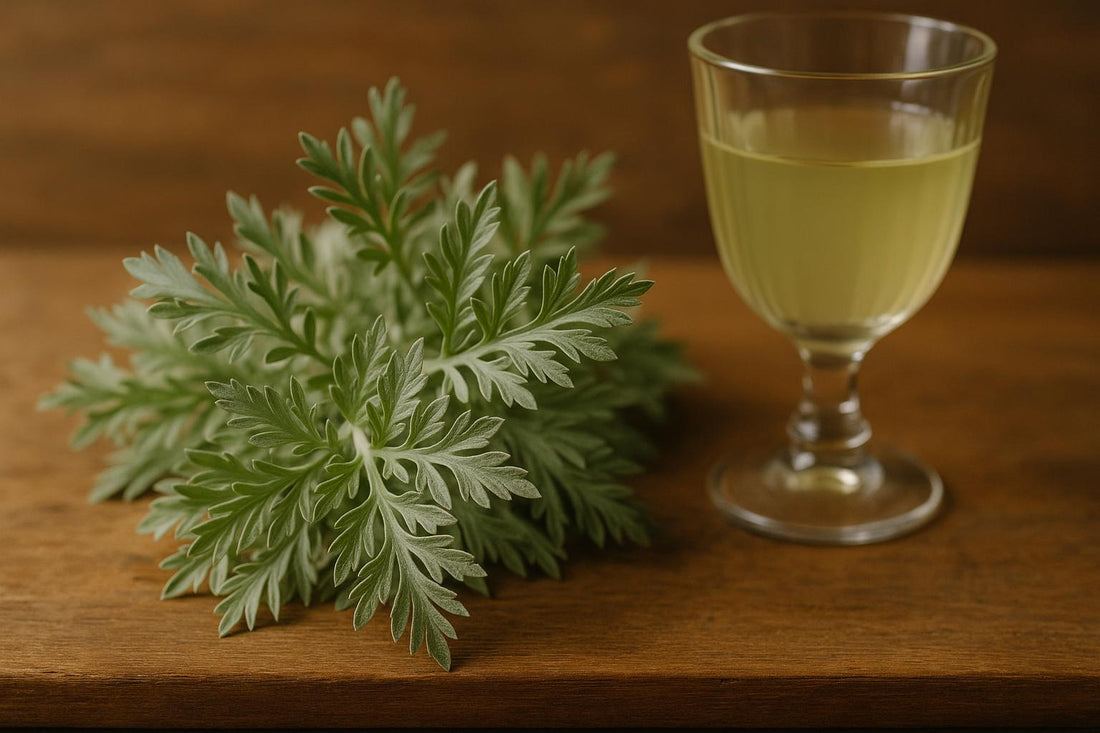Wormwood (Artemisia absinthium) is a perennial herb known for its bitter taste and aromatic qualities. Native to Europe, northern Asia, and North Africa, it is now found across the British Isles. Recognisable by its silvery-grey leaves and yellow flowers, wormwood's bitterness comes from compounds like absinthin and thujone. These properties make it a key ingredient in spirits like vermouth and amaro, where its sharp flavour balances sweetness and aids digestion.
Historically, wormwood was used in medicine to treat digestive issues and intestinal parasites. It also gained fame (and controversy) as a primary flavouring in absinthe, leading to strict regulations on its thujone content. Today, wormwood is safely used in aperitifs and cocktails, offering a bold, herbal bitterness that enhances drinks like Negronis and Manhattans. Modern producers, such as Asterley Bros London, continue to highlight its flavour in vermouths and amaros, blending heritage with contemporary cocktail culture.
Wormwood-based drinks are best enjoyed responsibly, often served before meals to stimulate appetite. Its bitterness pairs well with complementary ingredients like gin, rye whisky, or tonic water, making it a versatile choice for cocktails and aperitifs.
Botanical Properties of Wormwood
Appearance and Habitat
Wormwood stands out in the British countryside with its striking look. This medium to tall perennial typically grows to heights of 0.8 to 1.2 metres, occasionally reaching up to 1.5 metres in ideal conditions. Its stems are straight, grooved, and silvery-green, branching out as the plant matures.
The plant's leaves, which are deeply lobed and finely divided, spiral around the stem, creating a feathery effect. The upper side of the leaves appears greenish-grey, while the underside is white, both covered in soft, silvery-white hairs. Basal leaves can grow up to 250 mm long, while the smaller stem leaves usually measure between 50 and 100 mm.
Wormwood flowers in the UK from July to August, producing small, pale yellow tubular flowers about 3 mm in size. These flowers cluster into spherical, nodding heads that form long, leafy, branched panicles.
In Britain, wormwood thrives on uncultivated dry land, rocky slopes, roadside verges, waste areas, and coastal regions. While it is widespread across England and Wales, it is mainly found in coastal areas in other parts of Britain. Interestingly, wormwood is becoming increasingly rare and may not be a native species but rather an archaeophyte - an ancient introduction to the region.
Key Compounds and Properties
Wormwood is known for its strong sage-like aroma and intensely bitter taste. These characteristics have made it a key ingredient in spirit production for centuries.
Growing and Harvesting in the UK
In the wild, wormwood can be found across various habitats in Britain. It is particularly common in areas like Leicestershire and Rutland, showcasing its ability to adapt to different microclimates within the UK.
History and Background of Wormwood
Wormwood in Medicine
Wormwood has a long history in medicine, dating back to ancient civilisations like the Egyptians, Greeks, and Romans, who used it to address digestive issues and fevers. In medieval Britain, monastery gardens often cultivated the herb, where it was valued for treating stomach complaints and loss of appetite. Its bitter flavour was known to aid digestion. By the Tudor era, English herbalists such as John Gerard praised its versatility in his 1597 publication, The Herball or Generall Historie of Plantes, recommending wormwood for improving digestive health. British folk remedies also leaned on wormwood tea as a digestive aid, recognising its antimicrobial and insect-repellent properties. These early uses laid the foundation for wormwood's ongoing role in aperitivo traditions and its enduring medicinal reputation.
Folklore and Myths
Wormwood holds a prominent place in European folklore, often linked to themes of protection and purification. Its sharp bitterness and distinct aroma inspired various traditional beliefs, reflecting its cultural importance across centuries. While the specific practices varied from one region to another, wormwood consistently appeared in folk traditions, celebrated both as a healing herb and as a symbol in rituals. Beyond its medicinal uses, its association with protection gave it a near-mythic status in cultural narratives. However, its role in spirits like absinthe later brought about regulatory scrutiny, blending its folkloric identity with modern legal debates.
Legal and Social Developments
The legal history of wormwood is closely tied to the absinthe controversies of the late 19th and early 20th centuries. Absinthe, a potent spirit flavoured with wormwood, gained immense popularity across Europe, especially in France, where it was affectionately called "la fée verte" or "the green fairy."
By the early 1900s, concerns over absinthe's effects led to widespread bans. Switzerland was the first to outlaw it in 1910, followed by France in 1915, with other European nations imposing similar restrictions. These prohibitions were largely driven by worries about the drink's high alcohol content and the presence of thujone, a naturally occurring compound in wormwood, rather than the herb itself.
The United Kingdom, however, took a different approach. Instead of banning absinthe outright, British authorities chose to regulate thujone levels in alcoholic beverages. This allowed British distillers to continue using wormwood in products like vermouth and other aperitifs, even during the prohibition period elsewhere.
Today, European regulations set strict limits on thujone levels to ensure the safety of wormwood-based spirits. The lifting of absinthe bans across Europe, coupled with a growing interest in craft and botanical spirits, has reignited appreciation for wormwood's unique flavour. In the UK, regulations now support the controlled use of wormwood in spirit production, enabling artisanal producers to revisit traditional recipes while meeting modern safety standards. This balanced approach has encouraged innovation, particularly in the creation of premium vermouths and botanical aperitifs, keeping wormwood's legacy alive in British distilling.
Wormwood in Aperitivo Spirits and Vermouth
Flavour Contributions
Wormwood brings a bold, bitter complexity to aperitivo spirits, giving them a distinctive edge compared to other botanical drinks. Its primary role is to deliver a sharp, herbaceous bitterness that not only excites the palate but also preps the digestive system for a meal - making it a key ingredient in aperitifs.
In vermouth, wormwood acts as the cornerstone botanical, balancing the sweetness of ingredients like vanilla, citrus peels, and aromatic herbs with its evolving bitter profile. The natural compound absinthin in wormwood creates a layered flavour experience. It begins with a pronounced bitterness, transitions to earthy undertones, and finishes with a lingering herbal note that leaves you wanting another sip.
The way wormwood is processed significantly impacts its flavour. Fresh wormwood tends to have a more intense, almost medicinal bitterness, while dried wormwood produces a softer, more rounded bitter profile. Many high-end vermouth producers blend both forms to create a perfectly balanced flavour.
In amaro production, wormwood is often paired with other bitter botanicals like gentian root and cinchona bark. Its ability to add bitterness without overshadowing other flavours makes it an essential ingredient for well-rounded digestifs. Additionally, its volatile oils provide delicate aromatic notes that enhance the deeper bitter tones.
Asterley Bros London and Wormwood

Asterley Bros London is a shining example of how wormwood is being embraced in modern British distilling. This London-based company, founded by brothers Rob and Jim Berry, has carved out a niche with handcrafted English vermouth, amaro, and aperitivo spirits. Their creations highlight wormwood's unique qualities while blending traditional methods with contemporary cocktail culture.
Their English Vermouth showcases how wormwood can be harmonised with locally sourced botanicals to produce a distinctly British take on this classic aperitif wine. Each recipe reflects English tastes and celebrates the country’s rich drinking traditions.
Asterley Bros also explores wormwood's potential in their Amaro range, where its bitterness is balanced with other digestive botanicals to create complex, after-dinner spirits. These drinks pay homage to wormwood's historical medicinal uses while offering sophisticated flavours for today’s drinkers.
Through their Negroni Society - a subscription service priced at £14.50 for two expertly crafted Negronis - Asterley Bros demonstrates how their wormwood-based vermouths perform in various cocktail styles. Each month, subscribers receive a new Negroni recipe that highlights the versatility of their vermouth.
Their Vermouth Masterclasses provide a hands-on experience for enthusiasts, teaching how wormwood and other botanicals contribute to the production of aperitifs. These classes help participants dive deeper into the artistry behind these deceptively simple drinks, inspiring creativity in cocktail-making.
Cocktail Tips and Recipes
Working with wormwood-based spirits requires an understanding of how its bitterness interacts with other ingredients. Asterley Bros vermouth shines in stirred cocktails, where its botanical depth can take centre stage without being diluted by vigorous shaking.
For a classic Negroni, combine equal parts gin, vermouth, and Campari over a large ice cube, and garnish with an orange twist.
In Manhattan variations, wormwood-forward vermouths pair beautifully with rye whisky. The spicy notes from the rye complement wormwood's earthy bitterness, while the vermouth’s sweetness ties it all together. Use a 2:1 ratio of whisky to vermouth, stir with ice, and garnish with a cherry.
For Martini lovers, wormwood-based vermouth adds a layer of complexity that standard dry vermouths might lack. A 4:1 gin-to-vermouth ratio works well, allowing wormwood’s bitterness to balance the gin’s botanicals.
Proper chilling is essential to manage wormwood’s bitterness and unlock its aromatic qualities. Store opened vermouth bottles in the fridge and aim to use them within six weeks for the best flavour.
For longer, refreshing drinks - perfect for summer - wormwood-based aperitifs are an excellent choice. Try mixing Asterley Bros vermouth with tonic water, a sprig of fresh rosemary or thyme, and a citrus garnish over ice. The interplay between wormwood’s bitterness and the quinine in tonic creates a drink that’s both invigorating and subtly layered.
sbb-itb-f74956d
Health, Safety, and Modern Use
Past and Present Uses
Wormwood has long been celebrated for its digestive benefits, a reputation that stretches back centuries. Its bitter compounds, particularly absinthin, play a key role by activating taste receptors that signal the stomach to prepare for food. This explains why wormwood became a staple ingredient in pre-dinner drinks, designed to stimulate appetite and aid digestion.
Modern research backs up these traditional uses, confirming that wormwood’s bitter compounds encourage gastric secretions and improve appetite. However, in contemporary wormwood-infused drinks like aperitivos, the focus has shifted from medicinal purposes to enjoyment. These drinks contain moderate doses of the herb, offering digestive benefits without the intensity of concentrated herbal remedies.
Safety and Regulations
When it comes to safety, the primary concern with wormwood is thujone, a compound that can be toxic in large amounts. To address this, strict regulations govern wormwood-containing spirits in the UK and across the European Union. For instance, EU rules cap thujone levels in spirits at 10 mg/litre, ensuring a wide safety margin.
To put this into perspective, a standard 50ml serving of vermouth contains roughly 0.5 milligrams of thujone - far below harmful levels. The European Food Safety Authority recommends that daily thujone intake should not exceed 0.1 milligrams per kilogram of body weight. This means a 70kg adult could safely consume up to 7 milligrams of thujone per day, well above what you'd typically ingest from a few aperitifs.
Producers like Asterley Bros London adhere to these regulations, using traditional methods that naturally keep thujone levels low. Their maceration and distillation processes extract the desired bitter compounds while minimising thujone concentration, ensuring both quality and safety.
That said, certain groups should avoid wormwood altogether. Pregnant women, for example, should steer clear, as thujone can cross the placental barrier. Similarly, individuals with epilepsy or neurological conditions should consult a healthcare provider before consuming wormwood-based drinks.
To further protect consumers, regulations require clear labelling of ingredients and alcohol content on all wormwood-containing spirits sold in the UK. This transparency allows people to make informed decisions about their consumption.
Responsible Enjoyment
Savouring wormwood-infused aperitifs responsibly involves understanding both their alcohol content and the unique properties of their botanicals. Vermouths typically range from 15-18% alcohol by volume - stronger than wine but milder than spirits. Traditional serving sizes of 50-75ml, often diluted with ice, tonic water, or incorporated into cocktails, make it easier to enjoy these drinks in moderation.
The timing of consumption also matters. Wormwood’s bitter compounds are most effective when taken 15-30 minutes before a meal, giving your digestive system time to respond. This traditional practice not only enhances digestion but also naturally limits overconsumption, as the drink is followed by food.
For social occasions, consider offering lower-alcohol options alongside traditional aperitifs. Many wormwood-based drinks can be “lengthened” with sparkling water or tonic, reducing the alcohol content while maintaining their digestive benefits. Pairing these drinks with food further promotes responsible enjoyment. Classic accompaniments like olives, nuts, or small canapés not only complement the bitter flavours but also slow alcohol absorption.
If you’re new to wormwood-based spirits, starting with classic cocktails like the Negroni or Manhattan is a great way to ease in. These recipes balance wormwood’s bitterness with other ingredients, letting you appreciate its complexity without overwhelming your palate.
One thing to keep in mind: wormwood’s bitter compounds can mask the taste of alcohol, making it easier to drink more than intended. Stick to recommended serving sizes and pay attention to your consumption, especially when trying new products or cocktails. By following these guidelines, you can enjoy wormwood’s rich flavours and traditional digestive benefits safely and responsibly.
Conclusion
Key Takeaways
Wormwood carries a legacy that spans centuries, bringing its characteristic bitter profile to the world of aperitivo spirits. Compounds like absinthin, once valued for their medicinal properties, now play a key role in crafting modern aperitifs. This dual identity highlights wormwood's ability to bridge its historical applications with its contemporary use in balancing the flavours of aperitivo cocktails.
Historically, wormwood's enduring popularity speaks volumes about its appeal. Today, producers continue to harness its unique qualities, creating drinks that not only feature complex flavours but also encourage a mindful and enjoyable drinking experience.
Celebrating Wormwood in Spirits
The beauty of wormwood truly comes to life in handcrafted spirits, where traditional methods meet modern expertise. Asterley Bros London is a standout example, using meticulous maceration and distillation techniques to bring out wormwood's signature bitterness. Their vermouths and amaros are a testament to how this ancient ingredient can transition from traditional recipes to sophisticated, contemporary drinks.
Rob and Jim Berry have mastered the art of showcasing wormwood's depth, blending its historical roots with modern cocktail innovation. Through their Negroni Society subscription, priced at £14.50 per month, members can explore creative recipes that highlight the versatility of traditional botanicals.
For those curious about wormwood's potential, the possibilities are vast. It can be savoured neat as a digestif, paired with tonic water for a refreshing aperitif, or featured in classic cocktails like the Negroni or Manhattan. Wormwood-based spirits offer a rich blend of tradition and innovation, inviting a new generation to discover and appreciate its complex, timeless flavour.
Wormwood/Absinthe - History's Hallucinogenic Hoax [with Taste-Test]
FAQs
Is thujone in wormwood safe, and how is it managed in modern spirits?
Thujone, a naturally occurring compound in wormwood, can be harmful in large doses, with effects that may include convulsions. However, modern spirit production adheres to strict safety standards. In the UK and EU, regulations cap the thujone content in spirits such as absinthe at 35 mg/kg.
These measures make it possible to use wormwood safely in spirit production, preserving its distinctive flavour and traditional importance without endangering consumers.
What role does wormwood's medicinal history play in modern aperitivo culture?
Wormwood has a long history in traditional medicine, particularly for its role in supporting digestion, which has shaped its importance in today’s aperitivo culture. Its historical ties to health and wellness make it a natural fit for spirits like vermouth and amaro, often sipped as pre-meal or digestive drinks.
With roots in ancient and monastic traditions, wormwood carries a sense of heritage that adds both depth and character to its use. In the UK, its role in aperitivo culture connects the past with the present, blending its medicinal legacy with its ability to create complex, bittersweet flavours.
How can I use wormwood-based spirits in cocktails as a beginner?
For those unfamiliar with wormwood-based spirits, it’s best to begin with small amounts to get a feel for their distinct herbal character. Try adding a splash of absinthe or a touch of wormwood-infused vermouth to familiar cocktails, like a gin and tonic or a light spritz. This way, you can enjoy the layers of flavour without overwhelming the drink.
You can also play around with recipes that soften wormwood’s bold, bitter edge by pairing it with citrus or sweet elements - a squeeze of lemon or a drizzle of honey works wonderfully. Remember, a little goes a long way. Wormwood’s strong profile can easily take over, so take it slow and adjust until you find the perfect balance for your palate.

